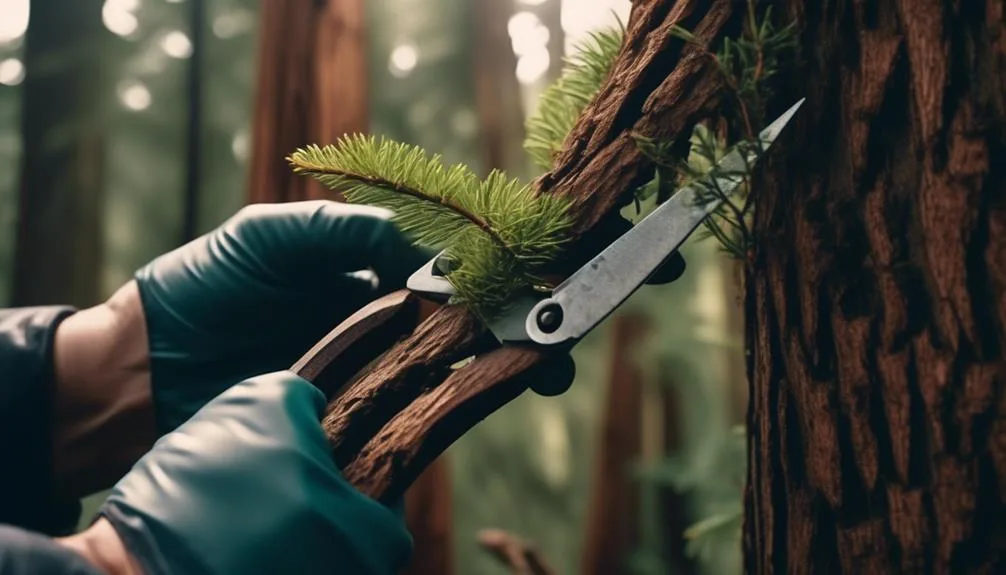Redwood trees are known for their impressive height, reaching over 300 feet.
Surprisingly, you can grow your own redwood trees from cuttings with the right know-how.
Before you picture your own redwood forest, it's crucial to grasp the key steps.
Let's explore the process of propagating redwood trees from cuttings.
You'll be amazed at what you can achieve.
Selecting the Cutting Location
To ensure successful propagation, it's crucial to select a healthy, vigorous branch for your redwood tree cutting. When identifying the optimal location, look for a branch that's about the thickness of a pencil and free from any signs of disease or damage. This branch should ideally be located on the upper part of the tree where it receives good sunlight.
Ensuring proper moisture levels is also essential. Once you've identified the right branch, it's important to keep the cutting moist before planting it. You can achieve this by placing the cutting in a plastic bag with some damp paper towels. Avoid letting the cutting dry out during this process.
Preparing the Cutting
Once you have selected a healthy branch for propagation, the next step is to prepare the cutting for planting. Here's how to do it effectively:
- Pruning Techniques: Trim the cutting at a 45-degree angle using sharp, clean pruning shears. Remove any excess leaves or side branches to promote successful rooting.
- Rooting Hormone Application: Dip the cut end of the cutting into rooting hormone powder, ensuring a light, even coating. This will encourage the development of roots and increase the cutting's chances of successful propagation.
- Cutting Length: Aim for a cutting that's 4 to 6 inches long, as this size has been found to be optimal for redwood propagation.
- Remove Bottom Leaves: Strip off the lower 1/3 of the leaves from the cutting. This will help reduce moisture loss and promote root development.
- Prepare Multiple Cuttings: It's a good idea to prepare several cuttings to increase the likelihood of successful propagation.
Planting the Cutting
After preparing the cutting, you are now ready to plant it for successful propagation of your redwood trees. Proper planting is crucial for the cutting to take root and grow into a healthy tree. When planting the cutting, ensure that the soil is well-draining and moist. Here's a helpful table to guide you on the watering frequency and sunlight exposure for your redwood tree cuttings:
| Stage of Growth | Watering Frequency | Sunlight Exposure |
|---|---|---|
| Initial Planting | Keep soil moist, not waterlogged | Partial shade to avoid stress |
| Root Development | Water when the top inch of soil is dry | Partial shade to dappled sunlight |
| Established Roots | Water deeply once a week | Full sun for healthy growth |
Caring for the Cutting
For successful propagation of your redwood tree cuttings, it's essential to provide proper care for the cutting as it establishes its roots and begins to grow. Here are some key care tips:
- Watering frequency: Ensure the soil remains consistently moist but not waterlogged. Water whenever the top inch of soil feels dry to the touch.
- Sunlight exposure: Place the cutting in a location with indirect sunlight to prevent it from drying out, but avoid direct intense sunlight that may scorch the delicate new growth.
- Humidity control: Maintain a high level of humidity around the cutting by misting it regularly or covering it with a transparent dome to retain moisture.
- Temperature regulation: Keep the cutting in a warm area with temperatures around 65-75°F (18-24°C) to promote root development.
- Monitoring for pests and diseases: Regularly inspect the cutting for any signs of pests or diseases and take prompt action if needed.
Monitoring Growth and Success
To monitor the growth and success of your redwood tree cuttings, regularly assess their development and make adjustments to ensure optimal conditions for rooting and healthy growth. Measuring progress will help you determine if the cuttings are thriving or need intervention. Look for new growth, such as emerging leaves or roots, as indicators of successful propagation. Additionally, keep an eye out for any potential issues such as yellowing or wilting leaves, which could signal problems with moisture levels or disease. By identifying potential issues early, you can take corrective measures to improve the chances of successful propagation. Monitoring the growth of your redwood tree cuttings allows you to intervene promptly, ensuring the best possible outcomes for your new plants.
| Measuring Progress | Identifying Potential Issues | Making Adjustments |
|---|---|---|
| Look for new growth such as leaves or roots | Check for yellowing or wilting leaves | Adjust moisture levels if necessary |
| Monitor overall health and vitality | Inspect for signs of disease | Provide appropriate light and temperature |
| Track the development of root systems | Ensure proper drainage | Prune any unhealthy or overcrowded growth |
Conclusion
As you embark on growing your own redwood forest from cuttings, remember the importance of selecting healthy specimens. Nurture them in well-draining soil and attentively monitor their progress. With dedication and patience, you'll soon witness the flourishing of new redwood trees. This will bring enduring joy for years to come.
Happy propagating!
Mark Hoffman is a dedicated arborist and tree care specialist with over a decade of experience. His love for trees began when he visited Yosemite National Park as a teenager and was awestruck by the giant sequoias. Mark pursued his passion by studying forestry at Michigan Technological University, where he earned a Bachelor of Science degree.
Since then, he has worked tirelessly in the field of arboriculture, helping to preserve and protect trees in his community. His expertise and dedication have made him a respected leader in the industry and a valuable resource for anyone seeking advice on tree care.
